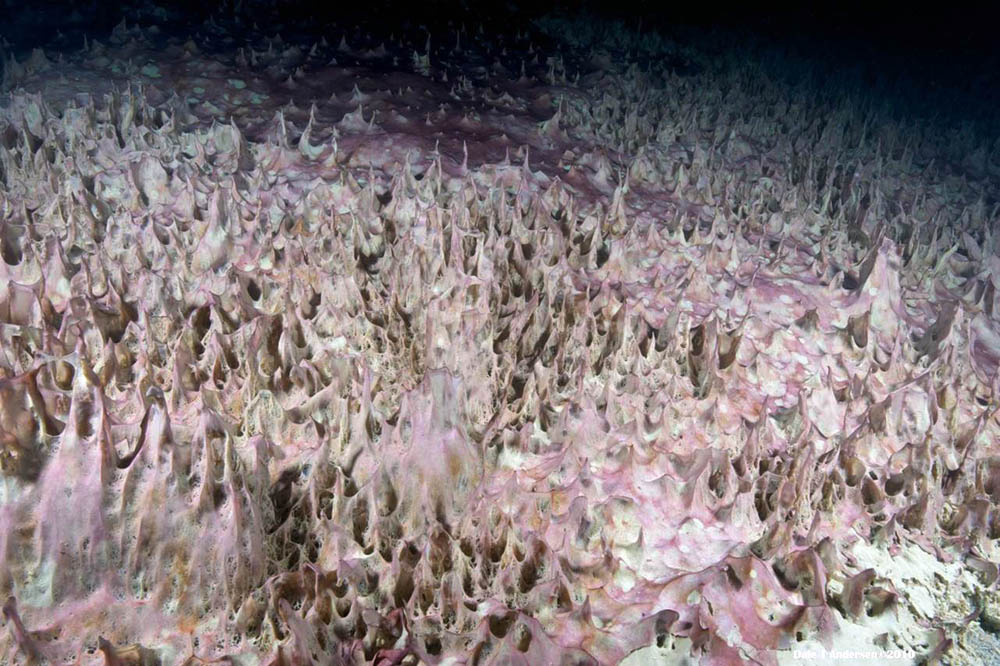Window to the pastBacterial mats in Dry Valleys lake sheds light on 2.5-billion-year-old organismsPosted January 2, 2015
Tyler Mackey slips through a hole in an ice-covered lake, dropping a dozen meters into the near-freezing water and diving back about 2.5 billion years into the past. This trick of time travel isn’t science fiction, though the otherworldly view of what first appear to be small-scale stalagmites on the lake floor could be mistaken for another planet. The formations are not lifeless mineral deposits that form on cave floors, but rich mats of bacteria and other microorganisms that build structures reminiscent of organisms that lived billions of years ago before the rise of more complex life forms on Earth. “It’s beautiful down there. It’s an alien landscape,” said Mackey, a doctoral student in the Department of Earth and Planetary Sciences at the University of California, Davis. “When you go under the lake ice, it’s just [a] lush growth of bacteria. It’s a very strange knowledge that you are, by orders of magnitude, the largest organism in this setting.” Mackey led a small field team this year to explore that alien landscape of Lake Joyce, one of about a dozen perennially ice-covered lakes in the McMurdo Dry Valleys, a polar desert and one of the only relatively ice-free regions in Antarctica. The small lake, only about a square kilometer in area and 55 meters or so at its deepest point, is one of the very few places in the world where cyanobacteria form thick mats that feature these particular webbed pinnacles. The structures are called microbialites, partly composed of calcium carbonate, which is the same mineral that makes up coral reefs and provides the rigidity for the microbial mat formations. Scientists have known about microbial mats in the Dry Valleys lakes since the 1970s during some of the first diving expeditions there. Mackey’s own research on the microbialites began in 2009 under Dawn Sumner, a geology professor at UC Davis who is the principal investigator on the Lake Joyce project. Her lab also studies truly alien landscapes as part of the Mars Rover Curiosity program. The research is related in a way. “If we were to find evidence of life in another setting, it would probably look like a microbial mat,” Mackey said. “Early Earth is the most alien environment that we know had life, so better understanding how that ecosystem functioned and how that ecosystem was preserved can give us a better dataset to take to other planets.” The most recent project at Lake Joyce, funded by NASA’s Exobiology and Evolutionary Biology Program In particular, the team is interested in how sediment entering the lake affects the growth of the bacterial communities. On one side of the lake is a delta system where more material is dumped into Joyce than anywhere else along its shoreline. One of the key questions – What is the connection between mat morphology and sedimentation? – is important in interpreting the ancient microbialite fossils that are found in places like South Africa and Australia. To figure out sediment loading on microbialite structures the researchers first made the most detailed map to date of the lake bottom bathymetry. The previous effort was a hand drawn map from 1973. Much has changed since then, not least of which is the lake level, which has risen about nine meters in the last 40 years. That has effectively stopped the accumulation of microbialite structures that are now deeper in the lake because the bacteria rely on photosynthesis for growth, though other microbial life still exists. “It’s pretty significant if you’re a bacterium on the bottom of the lake making your living from the stray photons that get through,” Mackey explained. “They are effectively relics of former lake levels.” The fieldwork involved drilling several dozen holes through the ice cover, as much as six meters thick in places, and dropping down special cameras to survey the lake bottom and microbialite structures. Other instruments took measurements of water temperature and salinity. All that work was conducted through a hole only about 12.5 centimeters wide. “It’s like building a ship in a bottle at the bottom of the lake,” Mackey said of deploying and operating the instruments from the surface of Lake Joyce. He and colleague Ian Hawes, a professor at the University of Canterbury in New Zealand, then got a closer look at targeted areas of the lake using scuba gear, collecting samples of the mats for molecular studies. Mackey likened collecting the samples to digging out slices of lasagna. The samples were returned to the surface in Tupperware containers. Finally, the team deployed special traps at four locations on the lake bottom to determine the rate of sedimentation. Some team members will return in a year to collect the instruments. The real work, as always, will begin back in the lab. However, some analyses at the field site from viewing the bacteria under a microscope found that communities were dominated by different cyanobacteria in pinnacle mats versus flat mats. More detailed work with sampled mats and DNA extractions will help answer questions about the makeup of the communities and their behaviors in the environment. In turn, that may offer more than a hint of how such life evolved and possibly helped transform the Earth itself: It was about that time – 2.5 billion years ago – that oxygen started to accumulate in the atmosphere. “It’s one of the biggest environmental changes to happen in Earth’s history,” Mackey said. “Lake Joyce is one of the few places on Earth where we can actually see these kinds of growth forms [similar to those in the fossil record]. It’s a valuable insight into that ancient environment.” |



For USAP Participants |
For The Public |
For Researchers and EducatorsContact UsNational Science FoundationOffice of Polar Programs Geosciences Directorate 2415 Eisenhower Avenue, Suite W7100 Alexandria, VA 22314 Sign up for the NSF Office of Polar Programs newsletter and events. Feedback Form |






